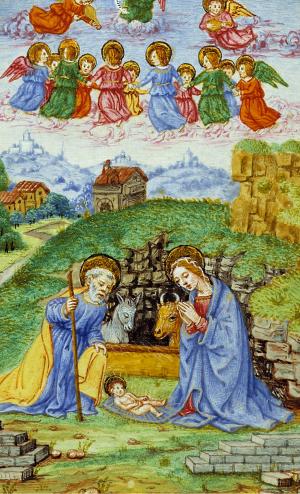|
Issue Date: December 26, 2003
St. Francis teaches us to love the Incarnation in all its forms By RICH HEFFERN Everyone loves the birdbath saint. St. Francis’ image graces many a front lawn and garden. This popular saint was a fruit of the blossoming of Christian compassion for nature and enthusiasm for poverty that took place in the 13th century. The Little Poor Man of Assisi’s practical love for all creation has endured for over eight centuries. Francis’ biographer, Thomas of Celano, noted that of all religious solemnities Christmas was the saint’s favorite. He called it “the Feast of Feasts, the day when God became a little child and nourished himself with the milk of a woman.”
The Poverello, in fact, invented the Christmas Nativity scene. When he and his friars had retreated to the Greccio region in central Italy, Francis one Christmas set up a real crib with some hay, with an ox and an ass, like those that held company with the child Jesus. Francis’ deep love for and devotion to Christ’s incarnation led him to this creative act. The people of the countryside joined the friars, bearing torches and candles in the night, to honor the Incarnation. To this day, when the Christmas season approaches we find ourselves placing those plaster figures in the manger, saving the little infant for last and then reverently laying him in his cradle. Francis prefigured such Christian theologians and thinkers as Frs. Pierre Teilhard de Chardin and Thomas Berry who urge us to remember the sacramental nature of creation. Francis’ spirituality was deeply incarnational. Russian writer and Nobel Prize winner Boris Pasternak wrote: “Because of Christ, we humans no longer die in the ditch like dogs.” Because we are made in the image and likeness of God, humans and our human-scale enterprises matter. Human endeavors and activities are the arena in which we lead lives that are profoundly spiritual. What’s the Christian religion’s bottom line? The Incarnation means that human life is intimately connected, in ways that are a mystery to us, with divine life. Poet and farmer Wendell Berry wrote a wonderful book called What Are People For? In it he asks pertinent, probing questions: Do communities and neighborhoods have spiritual value? What is the proper relationship between the scale of human activities and the estate of nature? Do we have the right to plow under topsoil to construct parking lots? Should we diminish human lives just to maximize profits? Wendell Berry was the keynote speaker at a conference I attended. After his address, he introduced to the assembly an Amish farmer he had brought with him from his native state of Kentucky. The Amish man was particularly eloquent describing life on very human-scale farms. During the question and answer period, someone asked him what these farm people did during the winter when the crops had been harvested and snow covered the fields. “Well,” he answered with a sly grin, “we take a lot of naps!” His answer got a standing ovation. That’s how hard naps are to come by in our overachieving, time-stressed world! What really appealed to the crowd, I believe, was the human scale of the Amish enterprise. Amish farms never grow too large lest they exceed the capacity of the community, necessitating inordinate time, expense or the use of more complicated machinery. The farmer talked of halting the communal hay-gathering machinery (horse-drawn, of course) to move a meadowlark’s nest from the cutting path. Profit was not the bottom line. Community, neighborliness and respect for the environment took first place. The Amish way leaves plenty of room for those timeless, deeply satisfying human things, like quilting, putting up preserves, playing horseshoes, talking, eating together and napping, to name a few. Their way recognizes and honors the idea that our human life, in all its humblest details and richness, is sacred in the eyes of God. For too long we have separated sacred and secular, relegating the sacred to certain places and people, while naming everything else as secular and devoid of the touch of divinity. In doing this we have profoundly devalued both the human and the natural world -- and paid the price for it in countless ways. Honoring the mystery of the Incarnation is the way out of this spiritual trap. Like Francis, we discover the compassionate face of Jesus every day, right here, right now, born anew over and over in the cradle of our human hearts. We humans matter, and the earth matters. Rich Heffern is former editor of Praying magazine and author of Daybreak Within: Living in a Sacred World (Forest of Peace). His e-mail address is heffern@diocesekcsj.org. National Catholic Reporter, December 26, 2003 |
 Holism is at the heart of the
Nativity
Holism is at the heart of the
Nativity